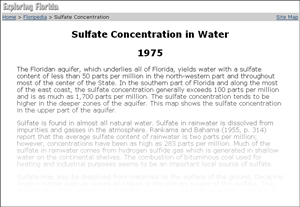Sulfate concentration in drinking water

Resource: Sulfate Concentration in Water, 1975
ACTIVITY
Using the resource from 1975, students will compare the suggested sulfate level to today's standards. Students can learn how to measure the minerals/chemicals/pollutants in water. Students can make a podcast (using Garage Band on a mac, Camtasia? on a PC) of a typical public service announcement (30 seconds to 1 minute). This PSA will aim to inform Florida's residents of the sulfate levels and what we can do to lower/raise them, etc.
Standards this activity addresses:
- Grades 9-12 (1996 Standards)
- Strand A - The Nature of Matter
- 1. The student understands that all matter has observable, measurable properties. (SC.A.1.4) BM 2
- Strand D - Processes that Shape the Earth
- 2. The student understands the need for protection of the natural systems on Earth. (SC.D.2.4) BM 1
- Strand G - How Living Things Interact With Their Environment
- 1. The student understands the competitive, interdependent, cyclic nature of living things in the environment. (SC.G.1.4) BM 3
- 2. The student understands the consequences of using limited natural resources. (SC.G.2.4) BM 2,4,5,6
- Strand H - The Nature of Science
- 1. The student uses the scientific processes and habits of mind to solve problems. (SC.H.1.4) BM 1, 2, 3, 4, 7
- 3. The student understands that science, technology and society are interwoven and interdependent. (SC.H.3.4) BM 1-6
- Grades 9-12 (2008 Standards)
- Body of Knowledge:
- Nature of Science
- Standard 1 - The Practice of Science SC.912.N.1.1 - N.1.7
- Standard 2 - The Characteristics of Scientific Knowledge SC.912.N.2.5
- Standard 3 - The Role of Theories, Laws, Hypotheses, and Models SC.912.N.3.1 - N.3.5
- Standard 4 - Science and Society SC.912.N.4.1, N.4.2
- Life Science
- Standard 17 - Interdependence SC.912.L.17.7, L.17.8, L.17.13, L.17.14, L.17.15, L.17.16, L.17.20